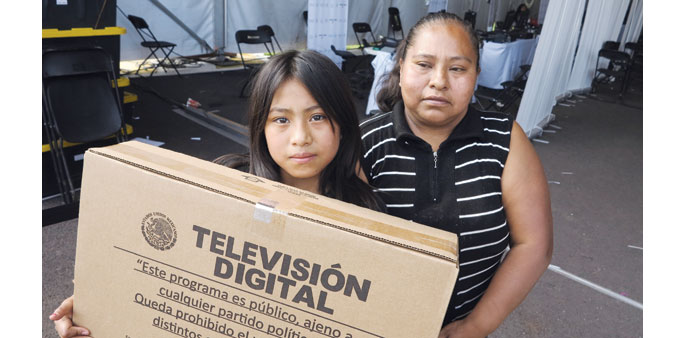Tomasa Lopez and her 11-year-old daughter Susana showing off the new digital television set they were given at a government distribution centre in Mexico City. Mexico’s government hopes to provide the 24-inch television sets free of charge to some 10mn citizens by the end of the year.
By Tim Johnson/Tribune News Service
Cradling a flat-screen television set in her arms, Tomasa Lopez beamed at her good fortune: She’d just taken part in the world’s biggest distribution of free digital televisions.
Lopez, a domestic servant, was among thousands of people who’ve thronged a cavernous tent in the populous working-class Iztapalapa district, one of hundreds of venues across Mexico where the poor are receiving some of the 10mn digital television sets the government is giving away at no charge.
It’s a programme costing the Mexican treasury $1.6bn in a push to convert the nation from analog television signals to a digital format. The US made the switch in 2009.
“I am happy,” Lopez said. “We’ve always wanted a digital television. We’ll see more channels. The kids will see cartoons.”
Other nations, such as Argentina, have given away digital television sets, but none on the scale of Mexico, and the programme has proved controversial. Critics question why the government of President Enrique Pena Nieto is giving away 24-inch flat-screen televisions, each costing around $145, when decoder boxes that allow older analog televisions to remain in use - the US solution - cost only about $40.
It’s not just the recipients of TVs who benefit. Television manufacturers clustered along Mexico’s northern border also profit, as do the two powerful media conglomerates that are moving quickly into digital services. The two companies will soon face competition from a third television network mandated into existence in 2013 with a constitutional reform to bring greater competition to the industry.
Already, the government has given away 4.6mn televisions in a massive operation that requires fleets of trucks to deliver the sets, and masses of workers to check documents, take fingerprints and scan the bar codes of the sets to ensure that each family gets only one.
Recipients are all low-income Mexicans who take part in one of several government social service programmes, including Prospera, which is the national crusade against hunger, and Liconsa, a subsidised milk programme.
A sense of urgency pervades the programme. The constitutional reform enacted in 2013 gives the government a deadline of December 31 to convert the nation to digital television. In recent weeks, government teams have been handing out 30,000 to 40,000 sets a day, but will have to double that figure to meet the deadline.
Administrators for the programme say it will have many benefits, among them raising the number of people with access to the Internet and cutting electricity usage.
“An analog television consumes 320 to 340 watts, and if you add a decoder then it’s another nine watts,” said Javier Lizarraga Galindo, an adviser behind the programme at the Communications and Transport Secretariat. “An energy efficient digital TV like the ones we are giving out in Mexico consumes less than 40 watts.”
Gabriel Sosa Plata, a professor at the Autonomous Metropolitan University and frequent commentator on television issues, said he thinks energy consumption might actually go up. Although analog signals are supposed to end on December 31, he thinks many people will buy decoder boxes and move the old sets into their children’s rooms.
“Instead of having just one television, they will have two, and that means more electricity consumption,” Sosa Plata said.
Skeptics also question whether the TVs really will make the Internet more accessible. The digital TVs offered by the state have USB and HDMI ports, but hooking them to the Internet would require additional hardware and, for now, a contract with a provider, though the government has pledged eventually to offer free wireless service.
Mexico already provides free Wi-Fi at or near public parks, squares and government buildings in most of the nation’s 2,400 municipalities and under the telecom reform is required to expand it to as many as 250,000 sites by 2018. Still only about 50% of Mexico’s 120mn citizens regularly access the Internet.
Criticism of the programme also has centred on the bidding for the purchase of the television sets. Mexico is the world’s largest assembler of TVs, producing between 35 and 40mn a year. Seven different companies with plants in Mexico, mostly along the US border, have taken part in supplying the programme.
“The first stage was not as transparent as it should have been. We were all suspicious,” said Jorge Negrete Pacheco, executive director of Mediatelecom, a consultancy in Mexico City on telecommunications regulation. “It was inevitable to think like this because none of the winners (of bids) were known brands.”
Negrete said the South Korean manufacturer Samsung was disqualified “for offering a better product” than required under the bid conditions. The winner of one bid sold televisions sets under the brand Diamante, largely unknown.



